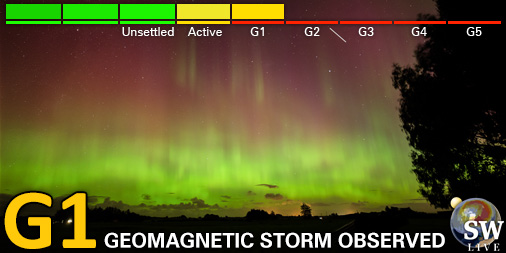Viewing archive of Saturday, 1 November 2014
Select the desired archive item
Goodbye sunspot region 2192, website updates
Solar activity is declining to lower levels as sunspot region 2192 has now rotated out of view and begins it's 2 week transit across the farside of the Sun. Sunspot region 2192 was the largest sunspot region in 24 years and it was exciting to follow it's development but we can conclude that it was perhaps a disappointing experience for aurora watchers around the world as sunspot region 2192 failed to launch any earth-directed coronal mass ejections. Sunspot region 2192 was nonetheless the type of sunspot region that we rarely see in any given solar cycle so of course it deserves our attention one more time. On YouTube we now have a video showing sunspot region 2192 as it evolved and the six X-class solar flares that it produced. But that's not all! We also introduced some new and exciting features today! We will tell you more about those later in this article.
Latest news
Latest forum messages
Support SpaceWeatherLive.com!
A lot of people come to SpaceWeatherLive to follow the Sun's activity or if there is aurora to be seen, but with more traffic comes higher server costs. Consider a donation if you enjoy SpaceWeatherLive so we can keep the website online!

Latest alerts
14:00 UTC - Geomagnetic activity
Minor G1 geomagnetic storm (Kp5) Threshold Reached: 13:52 UTC
12:00 UTC - Geomagnetic activity
Minor G1 geomagnetic storm (Kp5) Threshold Reached: 11:42 UTC
09:39 UTC - Hemispheric Power Index
The OVATION model predicts the Hemispheric Power Index to reach 76GW at 10:30 UTC
03:39 UTC - Hemispheric Power Index
The OVATION model predicts the Hemispheric Power Index to reach 51GW at 04:37 UTC
02:30 UTC - Geomagnetic activity
Active geomagnetic conditions (Kp4) Threshold Reached: 02:24 UTC
Space weather facts
| Last X-flare | 2025/03/28 | X1.1 |
| Last M-flare | 2025/04/20 | M1.0 |
| Last geomagnetic storm | 2025/04/20 | Kp5 (G1) |
| Spotless days | |
|---|---|
| Last spotless day | 2022/06/08 |
| Monthly mean Sunspot Number | |
|---|---|
| March 2025 | 134.2 -20.4 |
| April 2025 | 119.2 -15 |
| Last 30 days | 113.3 -31 |





